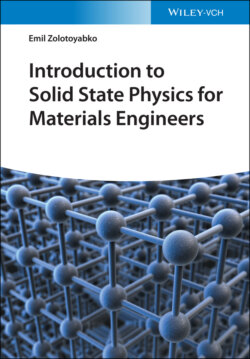Introduction to Solid State Physics for Materials Engineers

Реклама. ООО «ЛитРес», ИНН: 7719571260.
Оглавление
Emil Zolotoyabko. Introduction to Solid State Physics for Materials Engineers
Table of Contents
List of Tables
List of Illustrations
Guide
Pages
Introduction to Solid State Physics for Materials Engineers
Preface
Introduction
1 General Impact of Translational Symmetry in Crystals on Solid State Physics
1.1 Crystal Symmetry in Real Space
1.2 Symmetry and Physical Properties in Crystals
1.3 Wave Propagation in Periodic Media and Construction of Reciprocal Lattice
1.A Symmetry Constraints on Rotation Axes
1.B Twinning in Crystals
2 Electron Waves in Crystals
2.1 Electron Behavior in a Periodic Potential and Energy Gap Formation
2.2 The Brillouin Zone
2.3 Band Structure
2.4 Graphene
2.5 Fermi Surface
2.A Cyclotron Resonance and Related Phenomena
3 Elastic Wave Propagation in Periodic Media, Phonons, and Thermal Properties of Crystals
3.1 Linear Chain of the Periodically Positioned Atoms
3.2 Phonons and Heat Capacity
3.3 Thermal Vibrations of Atoms in Crystals
3.4 Crystal Melting
3.5 X-ray and Neutron Interaction with Phonons
3.5.1 Debye–Waller Factor
3.6 Lattice Anharmonicity
3.7 Velocities of Bulk Acoustic Waves
3.8 Surface Acoustic Waves
3.A Bose's Derivation of the Planck Distribution Function
4 Electrical Conductivity in Metals
4.1 Classical Drude Theory
4.2 Quantum–Mechanical Approach
4.3 Phonon Contribution to Electrical Resistivity
4.4 Defects' Contributions to Metal Resistivity
4.A Derivation of the Fermi-Dirac Distribution Function
5 Electron Contribution to Thermal Properties of Crystals
5.1 Electronic Specific Heat
5.2 Electronic Heat Conductivity and the Wiedemann–Franz Law
5.3 Thermoelectric Phenomena
5.4 Thermoelectric Materials
6 Electrical Conductivity in Semiconductors
6.1 Intrinsic (Undoped) Semiconductors
6.2 Extrinsic (Doped) Semiconductors
6.3 p–n Junction
6.4 Semiconductor Transistors
6.A Estimation of Exciton's Radius and Binding Energy
7 Work Function and Related Phenomena
7.1 Work Function of Metals
7.2 Photoelectric Effect
7.2.1 Angle-Resolved Photoemission Spectroscopy (APRES)
7.3 Thermionic Emission
7.4 Metal-Semiconductor Junction
7.A Image Charge Method
7.B A Free Electron Cannot Absorb a Photon
8 Light Interaction with Metals and Dielectrics
8.1 Skin Effect in Metals
8.2 Light Reflection from a Metal
8.3 Plasma Frequency
8.4 Introduction to Metamaterials
8.5 Structural Colors
8.A Acoustic Metamaterials
9 Light Interaction with Semiconductors
9.1 Solar Cells
9.1.1 The Grätzel Cell
9.1.2 Halide Perovskite Solar Cells
9.2 Solid State Radiation Detectors
9.2.1 Infrared Detectors
9.3 Charge-Coupled Devices (CCDs)
9.4 Light-Emitting Diodes (LEDs)
9.5 Semiconductor Lasers
9.6 Photonic Materials
10 Cooperative Phenomena in Electron Systems: Superconductivity
10.1 Phonon-Mediated Cooper Pairing Mechanism
10.2 Direct Measurements of the Superconductor Energy Gap
10.3 Josephson Effect
10.4 Meissner Effect
10.5 SQUID
10.6 High-Temperature Superconductivity
10.A Fourier Transform of the Coulomb Potential
10.B The Josephson Effect Theory
10.C Derivation of the Critical Magnetic Field in Type I Superconductors
11 Cooperative Phenomena in Electron Systems: Ferromagnetism
11.1 Paramagnetism and Ferromagnetism
11.2 The Ising Model
11.3 Magnetic Structures
11.4 Magnetic Domains
11.5 Magnetic Materials
11.6 Giant Magnetoresistance
11.A The Elementary Magnetic Moment of an Electron Produced by its Orbital Movement
11.B Pauli Paramagnetism
11.C Magnetic Domain Walls
12 Ferroelectricity as a Cooperative Phenomenon
12.1 The Theory of Ferroelectric Phase Transition
12.2 Ferroelectric Domains
12.3 The Piezoelectric Effect and Its Application in Ferroelectric Devices
12.4 Other Application Fields of Ferroelectrics
13 Other Examples of Cooperative Phenomena in Electron Systems
13.1 The Mott Metal–Insulator Transition
13.2 Classical and Quantum Hall Effects
13.3 Topological Insulators
13.A Electron Energies and Orbit Radii in the Simplified Bohr Model of a Hydrogen-like Atom
Further Reading
List of Prominent Scientists Mentioned in the Book
Index
WILEY END USER LICENSE AGREEMENT
Отрывок из книги
Emil Zolotoyabko
.....
For the fourth rank tensor, there are several optional ways for its construction. It may connect two tensors of rank 2, e.g. stress, σik, and strain, elm, as the stiffness tensor, Ciklm (tensor of elastic modules used in Chapter 3), does:
(1.18)
.....